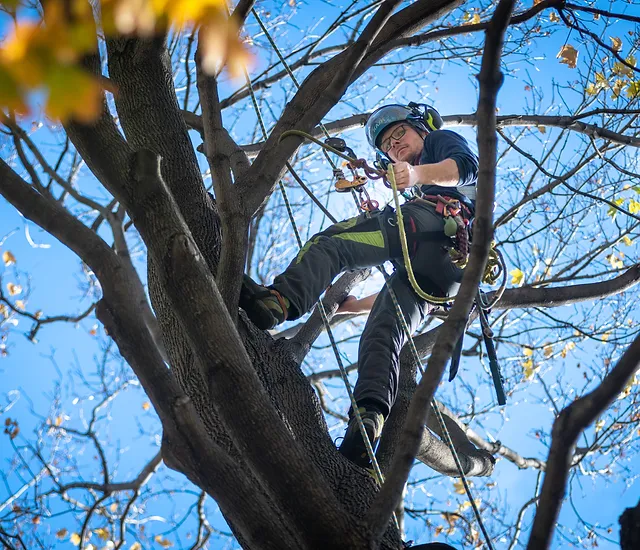Waterfront living in Belleair has its perks—stunning sunsets, ocean breezes, and a peaceful atmosphere. But if you have trees on your property, there are also risks lurking that most homeowners don’t think about until it’s too late. From salt damage to hurricane hazards, trees near the coast face unique challenges that can put your home, your safety, and your property value at risk.
That’s why identifying tree hazards for waterfront homes is something every Belleair resident should take seriously. Whether it’s a leaning palm or an overgrown oak, early action can save you thousands and protect your home from avoidable disasters.
Let’s walk through the biggest tree risks for waterfront homes—and what you can do to manage them.

Saltwater Exposure: A Hidden Threat to Tree Health
If your trees are anywhere near the shoreline, they’re probably dealing with salt stress—even if you can’t see it. Salt spray from the Gulf settles on leaves and gets into the soil. Over time, this salt buildup dries out roots and damages internal tissues, a condition known as physiological drought.
Trees like maples, cedars, and even some palms can show signs of salt burn—yellowing leaves, stunted growth, and tip dieback. The issue isn’t just cosmetic. A tree weakened by salt exposure becomes more vulnerable to pests, disease, and breakage during storms.
Planting salt-tolerant species like sabal palms or sea grapes helps. But if you already have sensitive trees, regular watering (to flush out salt) and professional fertilization can protect root health. Mulching also helps retain moisture and buffer salt damage.
High Wind and Hurricane Vulnerability
Storms don’t just blow through Belleair—they reshape it. Coastal winds, especially during hurricane season, can tear branches, uproot trees, or even send debris crashing into your home. Wind-loaded trees are one of the biggest dangers in waterfront areas.
Trees with dense canopies, shallow roots, or poor structure—like laurel oaks and ficus—are especially prone to windthrow and limb drop. If your tree leans toward the house or has double trunks, you’re looking at a structural red flag.
Strategic trimming can reduce wind resistance and prevent heavy limbs from becoming projectiles. In some cases, tree cabling and bracing might be needed to support weak limbs. ISA-certified arborists in Belleair specialize in this kind of preventive care, and it’s often cheaper than dealing with storm damage later.
Erosion and Soil Instability
One of the silent killers of trees along the waterfront is coastal erosion. As tides and rain slowly wear away the land, tree roots get exposed, making the tree unstable. This doesn’t just increase fall risk—it can also choke off the tree’s ability to absorb nutrients.
Look out for roots that are suddenly above ground or soil that’s sinking near the base. These are early signs your tree is losing its footing.
Installing root barriers can redirect root growth and prevent damage to seawalls and nearby structures. In some cases, regrading the land or adding retaining walls can help stabilize the soil and prevent root exposure.
Root Intrusion into Foundations and Utilities
Waterfront homes are often built on tighter plots, and that close proximity between trees and structures causes problems underground. Tree roots are opportunistic—they’ll grow wherever they find moisture, including pipes, septic tanks, and even the cracks in your home’s foundation.
Some species like ficus or camphor trees are known for aggressive root systems. Over time, they can cause foundation uplift, cracked patios, or blocked drainage systems.
If you notice slow drains or cracks near tree bases, root intrusion might be to blame. Root pruning and installing physical barriers underground are long-term fixes. Always work with a professional who can assess root patterns using air spading or ground-penetrating radar.
Overgrowth and HOA Violations
Many Belleair communities have strict guidelines about how trees should be maintained. Overgrown canopies, branches hanging over a neighbor’s fence, or unkempt hedges can land you in trouble with your HOA.
But this isn’t just about appearances. Overgrowth can block sightlines, interfere with power lines, and add unnecessary weight to limbs—making them more likely to snap in a storm.
Routine tree trimming every 12–18 months keeps trees healthy, compliant, and beautiful. And when done by an experienced team, it actually strengthens the tree rather than stressing it out.
Mangrove Mismanagement and Legal Consequences
If you have mangroves on your property, you’re not just dealing with trees—you’re dealing with protected coastal ecosystems. Florida law strictly regulates how mangroves can be trimmed or removed. Even touching them without the right permit can result in heavy fines.
Mangroves help prevent erosion, act as a storm buffer, and support marine life. Improper trimming can harm the entire shoreline.
Certified arborists in Belleair are trained to handle mangrove pruning legally and correctly. They understand the state’s Mangrove Trimming and Preservation Act and how to keep your property compliant while maintaining clear water views.
Fungal and Pest Infestation in Coastal Climates
High humidity, salty air, and dense vegetation create the perfect breeding ground for pests and fungal diseases. Waterfront trees often suffer from root rot, lichen overgrowth, borers, or scale insects that sap the life out of them slowly.
You might notice peeling bark, oozing sap, dead patches in the canopy, or powdery mildew. These aren’t just ugly—they’re signs of internal decay.
Treating infestations early with proper tree fertilization and fungicide applications can make a huge difference. Moss removal is also important, especially in older oaks that collect thick clumps of air plants and Spanish moss.
Tree Age and Structural Instability
Not all tree problems are caused by the weather or pests. Sometimes, age alone is the issue. As trees mature, they can become hollow, brittle, or overly top-heavy—especially if they haven’t been pruned properly over the years.
Older trees might look stable but can fall without warning if the trunk has internal decay or if roots have shrunk due to poor soil health.
A tree risk assessment by a licensed arborist uses tools like resistance drills or sonic tomography to check for hidden decay. Sometimes, the best choice is selective removal or reduction before the tree fails completely.
Final Thoughts: Waterfront Beauty Comes with Responsibility
Trees are a big part of what makes Belleair’s waterfront properties feel alive and luxurious. But left unmanaged, they can turn into serious liabilities—damaging property, endangering lives, and costing thousands in preventable repairs.
With the right care, you can protect your landscape while preserving the charm of coastal living. Work with local experts who know the challenges of tree care in Belleair and can offer long-term solutions—before the next storm or salt surge shows up at your door.
Need professional help assessing your trees? Reach out for a free quote from trusted local arborists who specialize in waterfront tree care.
